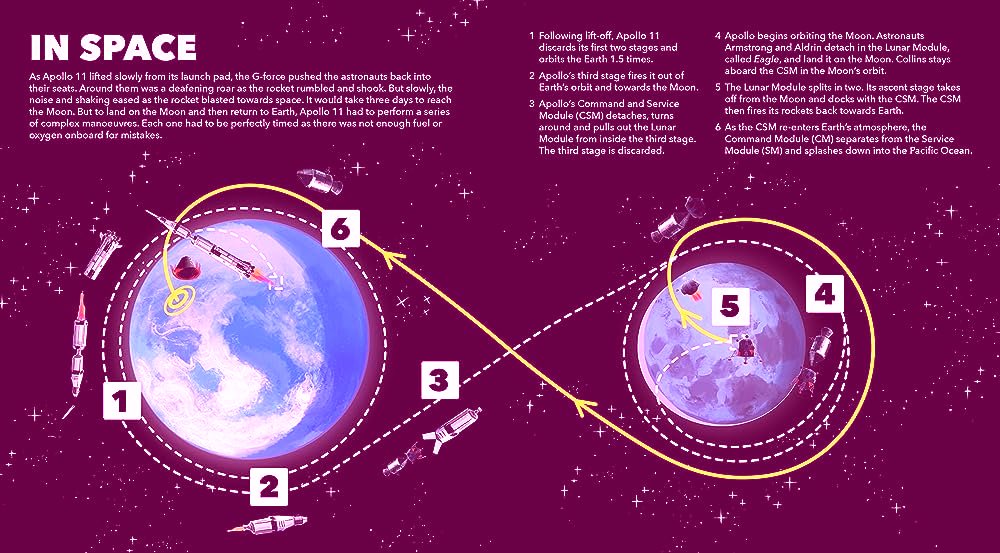The safe return of the Apollo 11 crew back to Earth represented the culmination of a meticulous orchestration of science, engineering, and teamwork. Understanding the intricacies of how the Apollo 11 mission returned to Earth holds profound significance, not only for the scientific community but also for humanity’s broader pursuit of exploration, technological advancement, and the inherent human desire to transcend the limits of our world. In this article, we explore the multifaceted importance of comprehending the complex journey that brought the Apollo 11 astronauts back from the Moon, delving into the scientific principles, engineering marvels, and enduring lessons that reverberate through the annals of human history.
- Ascent from the Moon: After spending approximately 21 hours on the lunar surface, Neil Armstrong and Buzz Aldrin transferred from the lunar module (Eagle) back to the command module (Columbia) for their journey back to Earth.

- Ascent Propulsion System Ignition: The ascent from the Moon’s surface began with the ignition of the ascent propulsion system (APS) engine on the lunar module. The APS was responsible for generating the thrust needed to lift off from the Moon’s surface and carry the astronauts back to lunar orbit to rendezvous with the Command/Service Module. This engine generated the thrust required to break free from the Moon’s gravitational pull. The APS was a hypergolic rocket engine, meaning it used a combination of two chemicals that ignite spontaneously upon contact with each other. The propellants used were Aerozine 50 (a mixture of hydrazine and unsymmetrical dimethylhydrazine) as the fuel and nitrogen tetroxide as the oxidizer. This combination is highly reliable and doesn’t require an external ignition source, which is especially important in the vacuum of space and on the Moon.
- Controlled Liftoff: The astronauts controlled the ascent stage’s orientation using the gimbaled APS engine. They steered the spacecraft to ensure a safe and accurate liftoff trajectory. The APS was crucial for ensuring a safe return of the astronauts from the lunar surface to lunar orbit. Its precise engineering and performance were essential for achieving the complex maneuvers required to rendezvous with the Command/Service Module in orbit. Without a reliable ascent engine, the astronauts would have been stranded on the Moon.
- Rendezvous with the Command/Service Module (CSM): After achieving lunar orbit, the ascent stage performed a series of maneuvers to rendezvous and dock with the CSM, which was piloted by Michael Collins. This docking was essential for transferring the astronauts and lunar samples.
- Transfer of Crew and Samples: Neil Armstrong and Buzz Aldrin transferred from the ascent stage to the CSM, along with lunar surface samples and experiments collected during their time on the Moon.
- Ascent Stage Jettison: Once the transfer was complete, the ascent stage of the lunar module was jettisoned. It was left in lunar orbit as the CSM prepared for its journey back to Earth.
- Preparation for Trans-Earth Injection (TEI): The CSM’s propulsion system was checked and prepared for the critical maneuver known as trans-Earth injection (TEI), which would send the spacecraft on a trajectory back to Earth.
- Trans-Earth Injection Burn: The TEI burn involved firing the CSM’s main engine to increase its velocity and escape the Moon’s orbit, setting it on a course for Earth. The reentry into Earth’s atmosphere marked the most perilous phase of the return journey. The Command Module, affectionately named “Columbia,” faced the daunting challenge of enduring extreme heat and deceleration forces. The heat shield, a testament to cutting-edge materials science, absorbed and dissipated heat, effectively creating a protective barrier that prevented the interior from being incinerated.
- Entry into Earth’s Atmosphere: As the CSM approached Earth, it reentered the planet’s atmosphere at high speed. The heat shield protected the spacecraft from the intense heat generated by atmospheric friction.
- Peak Heating Phase: The CSM experienced its most intense heating during reentry, reaching temperatures over 2,500 degrees Fahrenheit (1,370 degrees Celsius). The heat shield gradually ablated, dissipating the heat.
- Deceleration and Aerodynamic Forces: The aerodynamic forces created by the atmosphere’s drag began to slow down the CSM, subjecting the astronauts to high g-forces. As Columbia hurtled through the atmosphere, its streamlined design reduced the speed generated by friction with the air. This phase subjected the astronauts to intense G-forces akin to those experienced during launch. The deployment of drogue chutes and subsequently main parachutes served as a lifeline, slowing the descent to a manageable rate. This section expounds upon aerodynamic principles, drag, and parachute deployment dynamics.
- Parachute Deployment: After descending to a lower altitude, the CSM deployed its series of parachutes: drogue chutes and main parachutes. These chutes slowed the descent and stabilized the spacecraft.
- Stable Splashdown: The CSM safely splashed down in the Pacific Ocean, where recovery teams aboard ships were waiting. The spacecraft’s stabilization systems ensured a controlled landing on the water.
- Recovery by USS Hornet: The recovery ship USS Hornet quickly reached the CSM’s splashdown location. A helicopter retrieved the astronauts, and the CSM was retrieved from the water and secured for transport.
- Mission Accomplished: With the safe recovery of the astronauts and the spacecraft, the Apollo 11 mission was successfully concluded. The return to Earth marked the triumphant end of humanity’s first mission to land on the Moon.
These 15 steps showcase the intricacies of Apollo 11’s return journey, highlighting the complex maneuvers, engineering feats, and meticulous planning that ensured the astronauts’ safe passage from the lunar surface back to Earth.